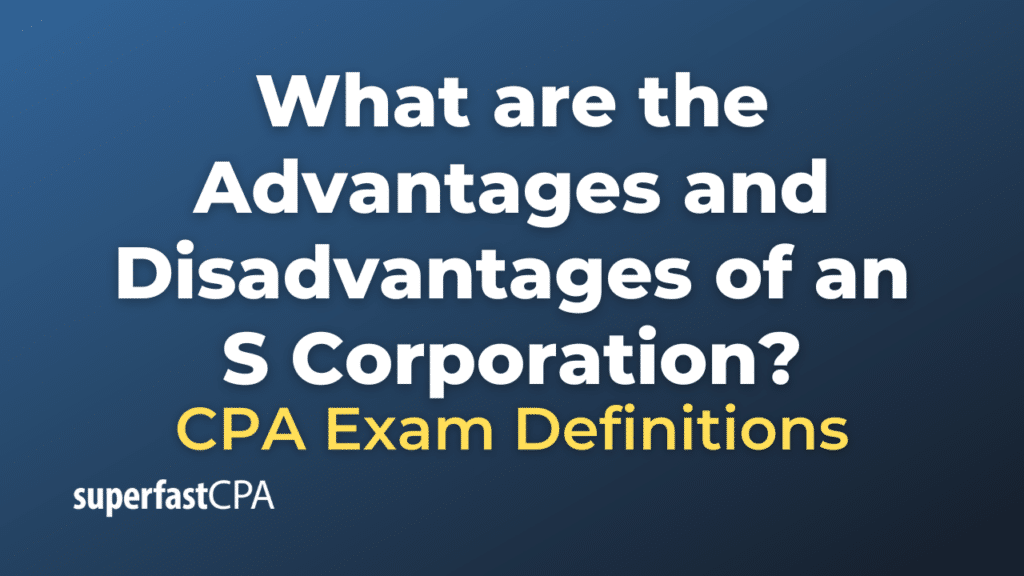Advantages and Disadvantages of an S Corporation
S corporations provide a unique blend of corporate and partnership characteristics. Here’s a breakdown of their advantages and disadvantages:
Advantages of an S Corporation:
- Avoidance of Double Taxation: Unlike C corporations where profits can be taxed at the corporate level and then again at the shareholder level when distributed as dividends, S corporations allow profits (and some losses) to pass through directly to the owners’ personal income without ever being subject to the corporate income tax.
- Limited Liability: Shareholders’ personal assets are generally protected from company debts or liabilities, similar to a C corporation.
- Transfer of Ownership : Ownership can be easily transferred through the sale of stock without affecting corporate operations.
- Perpetual Existence: The business can continue to exist even if the owner dies or leaves the business.
- Self-Employment Tax Savings: With an S corporation, only the salary paid to the owner-employee is subject to employment tax. The remaining income that is paid as a distribution is not subject to self-employment tax, potentially leading to tax savings.
- Credibility: Operating as a corporation can enhance credibility with customers, suppliers, and investors.
Disadvantages of an S Corporation:
- Restrictions on Ownership:
- There’s a limit on the number of shareholders (100 maximum).
- Shareholders must be U.S. citizens or resident aliens.
- Only individuals, certain trusts, and estates can be shareholders; partnerships and corporations can’t.
- There can only be one class of stock.
- Formation and Ongoing Expenses: There are initial setup costs and possible state-level fees or taxes for S corporations. Furthermore, there are ongoing corporate formalities, like annual reports and meetings, that can incur costs.
- Compensation Requirements : Shareholders who work for the company must receive reasonable compensation. If the IRS believes a shareholder-employee’s compensation is not reasonable (too high or too low), it might reclassify some of the earnings, which can result in additional tax liabilities.
- State Taxation: Some states do not recognize the S corporation designation and will tax such businesses as regular C corporations. Others may tax both the S corp’s profits and the shareholder’s proportional shares.
- Less Flexibility in Allocating Income and Loss : Unlike partnerships or LLCs taxed as partnerships, S corporations can’t allocate income, losses, deductions, and credits to shareholders in a manner that’s different from their pro-rata share or stock ownership.
- Paperwork: Even though S corps are simpler than C corps, there’s still a requirement for regular meetings, minutes, and formalities.
Deciding whether to structure your business as an S corporation requires careful consideration of these pros and cons, taking into account the specific circumstances of your business. Consulting with legal and financial professionals can provide more detailed guidance tailored to individual business needs.
Example of the Advantages and Disadvantages of an S Corporation
Maria is a graphic designer who has been operating as a sole proprietor for several years. Her business has been growing steadily, and she is now considering forming an S corporation.
Advantages in Maria’s case:
- Avoidance of Double Taxation: As her income increases, Maria realizes that by transitioning to an S corp, she can avoid the double taxation trap that C corporations face. If she were to make a net profit of $150,000 in a year, this entire amount would be passed directly to her personal income tax, without corporate taxation.
- Limited Liability: Maria recently secured a major client. By forming an S corp, if any contractual disputes arise, her personal assets (like her home and savings) are generally shielded from potential business liabilities.
- Self-Employment Tax Savings: As a sole proprietor, Maria pays self-employment taxes on her entire net income. If she forms an S corp and pays herself a “reasonable” salary of $75,000 (and takes the other $75,000 as a distribution), only the salary portion would be subject to employment taxes, leading to potential savings.
- Credibility: By operating under an S corp, Maria might appear more professional to potential clients and suppliers, possibly leading to more business opportunities.
Disadvantages in Maria’s case:
- Formation and Ongoing Expenses: Maria has to incur some expenses to set up her S corporation, including state filing fees. She also realizes she might need accounting or legal advice more frequently, which can increase her costs.
- Compensation Requirements: Maria has to ensure she pays herself a reasonable salary. If she tries to minimize this amount to save on employment taxes, the IRS could scrutinize her.
- State Taxation: Maria lives in a state that does not fully recognize the pass-through nature of S corporations. This means she might face some level of state corporate taxation, reducing the S corp’s tax benefits.
- Paperwork: As a sole proprietor, Maria was used to minimal paperwork. Now, she has to maintain proper corporate records, including minutes from meetings, even if she’s the sole participant.
After weighing the pros and cons, Maria decides to move forward with the S corporation structure, believing that the benefits, especially the tax advantages and limited liability, outweigh the disadvantages for her growing business. However, she also decides to consult regularly with an accountant to ensure she’s meeting all requirements and maximizing her benefits.













